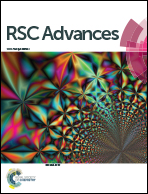Preparation of a novel thermo responsive PSF membrane, with cross linked PVCL-co-PSF copolymer for protein separation and easy cleaning
Abstract
An amphiphilic thermo responsive cross linked polyvinylcaprolactam-co-polysulfone (PVCL-co-PSF) copolymer was synthesized via solution polymerization of vinylcaprolactam (VCL) in PSF solution by use of three different initial ratios of PSF to VCL monomer. After the synthesis of the copolymer, the required amount of PSF was dissolved in PVCL-co-PSF copolymer solution. The presence of copolymer in the blended membrane was confirmed by Fourier transform infrared-attenuated total reflectance (FTIR-ATR) spectroscopy. Blended membranes showed enhanced pure water flux, hydrophilicity and evident thermo sensitivity. The hydration capacity for the modified membrane decreased from 279 to 161 mg cm−3 when the temperature changed from 25 to 40 °C. The hydration capacity of the modified PSF membrane compared to the plain PSF membrane increased from 127 to 279 mg cm−3, and the adsorbed protein amount decreased from 0.14 mg cm−2 to 0.03 mg cm−2 at 25 °C. The reversible volume phase transition of PVCL around the lower critical solution temperature (LCST) was used as an environmentally-friendly approach for membrane cleaning. A temperature change water elution hydraulic cleaning for the modified membranes around the LCST of the PVCL-co-PSF copolymer brushes was proposed (as shown in


 Please wait while we load your content...
Please wait while we load your content...